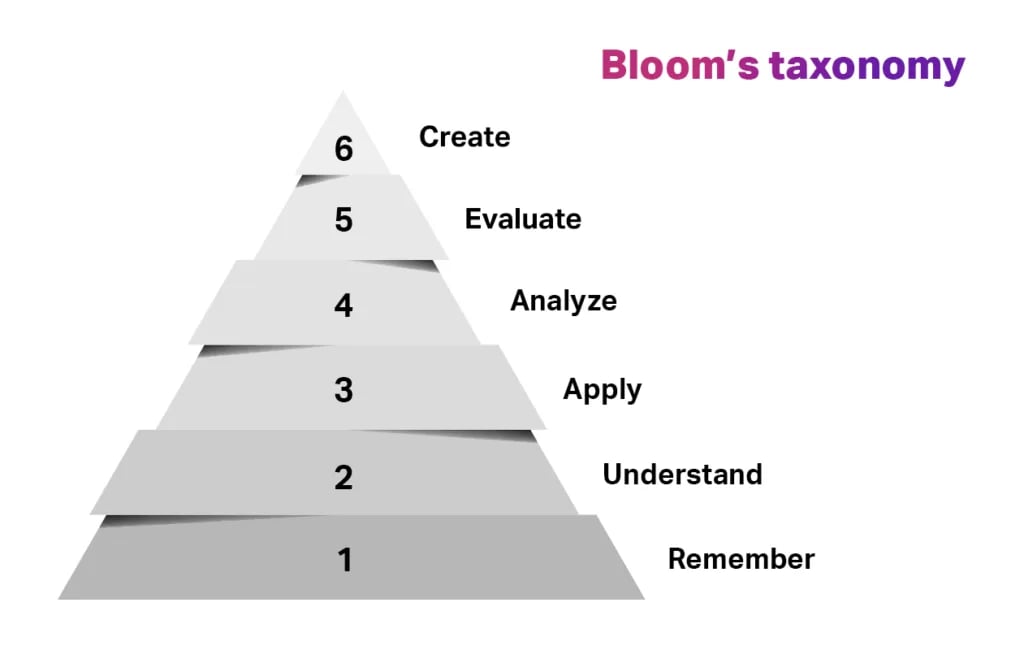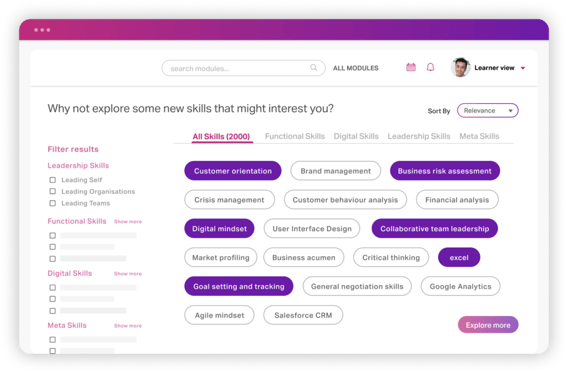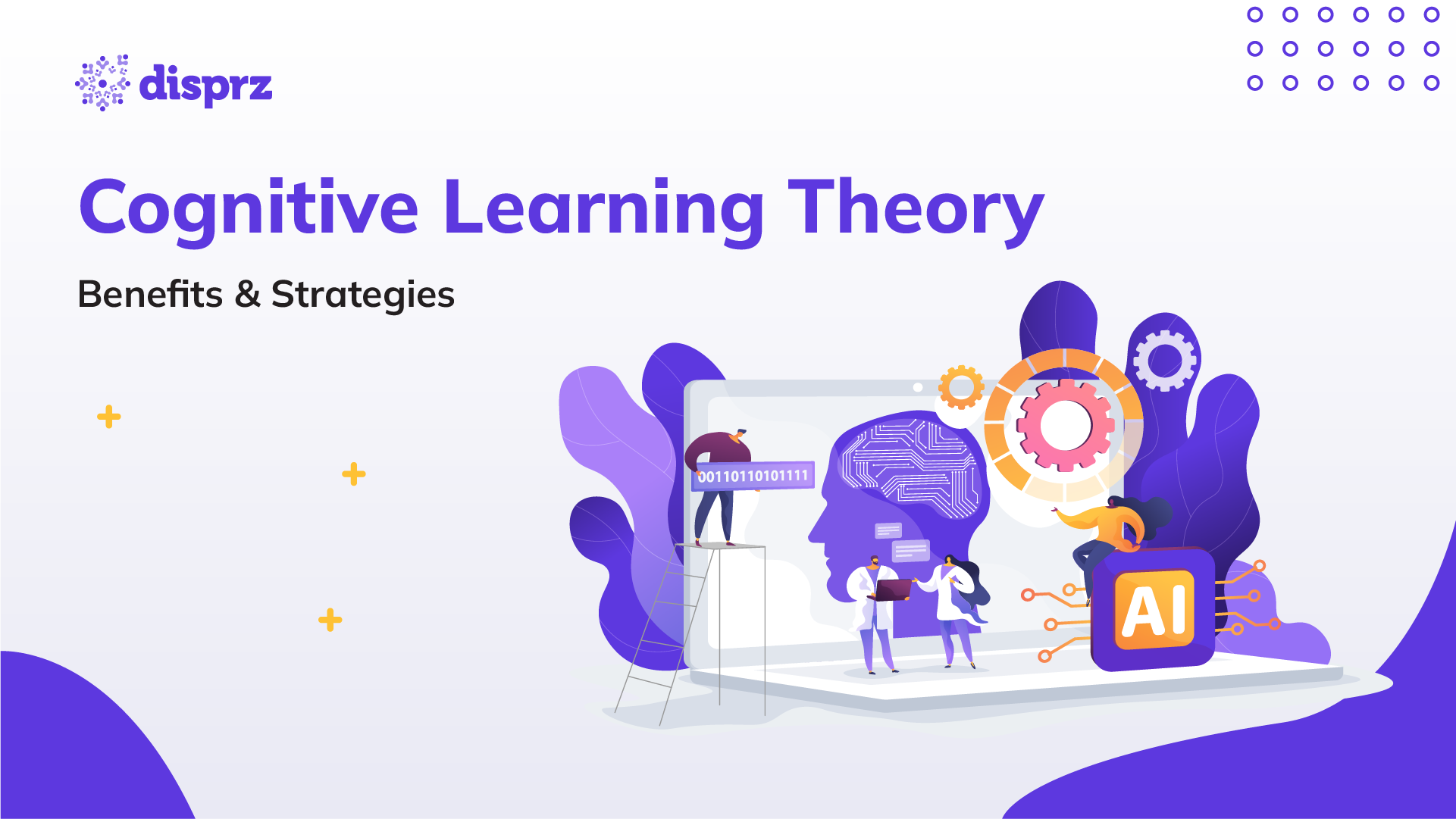There is a disconnect between employee learning and potential performance. This is clearly seen in a Harvard Business Review survey that found that 70% of employees report that they don’t have mastery of the skills needed to do their jobs
Traditional L&D programs have a learning style that does not succeed in developing the necessary skills for improving on-the-job productivity. This failure is due to a lack of focus on how employees receive, process, and apply the information presented during training. This challenge has led L&D leaders to explore the cognitive learning theory and how it can impact their upskilling programs.
According to most cognitive learning theorists, it is critical to understand the internal thought process of the learners. When learning programs are effective, employees store information in long-term memory and translate it into workplace performance. This is where cognitive learning has taken precedence over traditional learning methods, emphasizing the role of cognition in learning.
Creating an instructional design that incorporates cognitive learning strategies will use your employee’s mental process to build short-term memory and training into long-term upskilling and utilization. This can be accomplished with a variety of learning styles including in-person social settings and multimedia learning. Cognitive development is key to making an L&D program successful and understanding the cognitive approach to learning can significantly enhance employee upskilling efforts.
What is Cognitive Learning Theory?
Cognitive learning theory, also known as cognitivism learning theory, is an educational psychology approach that emphasizes how people actively process information to create knowledge and meaning. It is based on the concept of "metacognition," which means "thinking about one's thinking." This theory forms the foundation of cognitive learning psychology.
Jean Piaget, a well-known educational psychologist and the pioneer of Cognitive Learning Theory (CLT) believed that learning was an active process of creating knowledge within an individual’s mind.
According to Piaget, a learner’s behavior is influenced by their internal cognitive processes, including how they observe, organize, and interpret information. Therefore, it is essential to understand a learner’s learning process. To do so, we must focus not only on their external behavior but also on their internal behavior.
The cognitive learning theory is broad. It propels an individual to look at L&D from a wider perspective that involves attention, perception, memory, and problem-solving. This approach goes beyond just memorizing new information. It encourages consideration, application, and reflection.
Social cognitive theory is a strategy that incorporates observational learning, collaborative learning, and social learning as a learning style that can be done in a group or team setting. Employees will learn by watching peers, applying and repeating what was done, and having the learning concepts reinforced. This theory emphasizes the importance of social interactions in the learning process.
What is Cognitive Social Learning Theory?
Cognitive Social Learning Theory, often referred to interchangeably as Social Cognitive Learning Theory, was introduced by psychologist Albert Bandura. This theory emphasizes that people acquire new knowledge and behaviors not only through direct experiences but also by observing others in social contexts. In essence, it blends cognitive learning (internal thought processes) with social learning (external influences), making it highly relevant in today’s collaborative and connected work environments.
At the heart of this theory are three core components: observational learning, self-efficacy, and reciprocal determinism. Observational learning involves acquiring behaviors by watching others, such as a manager leading by example. Self-efficacy refers to an individual’s belief in their ability to complete a task, which directly influences their motivation and performance. Reciprocal determinism suggests that behavior, cognitive factors, and the environment all influence each other continuously.
In practical terms, social cognitive learning theory examples include mentorship programs, peer-to-peer learning, team-based projects, or video-based case studies where learners watch scenarios and apply learnings. This approach fosters not just knowledge retention but also the development of behavioral competencies essential for leadership, communication, and problem-solving.
In the context of workplace learning, this theory aligns with modern learning platforms that integrate social features, collaborative tools, and real-time feedback mechanisms. With the rise of GenAI and personalized LXP platforms such as Disprz, cognitive social learning can be embedded at scale; empowering employees to observe, reflect, and replicate best practices from others in their ecosystem.
4 Types of Cognitive Learning Theories
Here are the different types of cognitive learning.
1) Explicit learning theory
It occurs when you consciously seek information in an effort to pick up a new skill or method that might be essential to your line of work. To get information, you have to pay attention and do things. Taking a comprehensive video editing course to grasp the software's functionality and be able to use it correctly for your profession is one example of explicit learning.
2) Implicit learning theory
There are moments when you pick up new skills and information passively. Implicit learning is the process of retaining new information without your conscious knowledge. You might learn anything of this kind while conversing, working, or going about your daily activities. Implicit learning, which develops naturally over time, is exemplified by quick typing without looking at the keyboard.
3) Social learning theory
Albert Bandura created the Social Cognitive Theory (formerly known as the Social Learning Theory, or SLT) in the 1960s. The 1980s saw the adoption of the current moniker for this idea. According to social cognitive theory, learning takes place in a social setting where there is dynamic, reciprocal interaction.
4) Cognitive Behavioural Theory (CBT)
This theory, pioneered by Dr. Aaron T. Beck in the 1960s, asserts a strong connection between thoughts, feelings, and behaviors. It highlights the reciprocal relationship between external stimuli, internal sensations, and actions, emphasizing the potential for mental health improvement by consciously altering beliefs and behaviors, an approach increasingly supported by insights from mental health EHR systems. CBT's focus on meta-cognition, or thinking about thinking, underscores its relevance for learning and development, offering insights into how the cognitive learning processes impact behavior and emotional well-being.
Cognitive Learning Theories Examples 2025
1) Empowering Healthcare Professionals through Personalized Learning
Personalized learning at Disprz plays a crucial role in understanding the behavior, thoughts, and feelings of healthcare professionals. With the healthcare industry facing high attrition rates and a growing demand for skilled professionals, retaining talent is paramount. By offering upskilling and reskilling opportunities for career advancement, organizations can ensure employee engagement and satisfaction. Disprz's AI-powered learning experience platform (LXP) enables personalized learning tailored to individual job roles and learning preferences.
Through gamification elements like polls, quizzes, and interactive discussions, healthcare employees can engage in meaningful learning experiences. Features like breakout rooms and feedback mechanisms further enhance the effectiveness of L&D initiatives, ensuring continuous improvement and skill development.
2) Transforming Retail Employee Skills with Tailored Learning Paths
Disprz's personalization tailors learning for BHIMA Gold by analyzing behavior, emotions, and cognition. It tracks user interactions, gauges sentiment, and identifies learning styles. Adaptive paths suggest modules based on skill levels and interests. Real-time feedback supports timely assistance. This approach ensures a seamless and engaging learning experience across branches, boosting employee engagement and skill acquisition while reducing training costs and time.
3) Enhancing Insurance Agent Training with Netflix-style Personalization
Disprz's personalized LXP mirrors Netflix's adaptiveness, tailoring content based on user behavior, feelings, and thoughts. Like Netflix suggests shows, the LXP recommends courses aligned with job roles, skills, and interests. It offers flexibility too; for instance, incorporating proctored assessments to verify remote learners' identities. LXP's customizable nature and alignment with learners' needs make it an ideal tool for enhancing insurance agents' learning journeys.
How can the Cognitive Learning Theory impact Employee Upskilling?
Instead of just focusing on creating training sessions that fail to garner interest, companies are putting more effort into understanding the cognitive capacity of their employees. They are taking proactive steps to understand how employees learn and process information. This has helped in creating experiential learning that drives knowledge retention and boosts workplace performance.
In the context of employee upskilling, understanding the cognitive learning theory helps trainers design more immersive learning experiences. It helps them improve workplace performance by understanding the learner’s behavior. Moreover, it motivates learners to link new knowledge with prior knowledge and existing ideas to deepen their retention capacity.
4 Benefits of Cognitive Learning Theory in 2025
Cognitive learning theory is an effective way of upskilling the workforce. It ensures that employees engage fully in the learning process, gain in-depth understanding, and reflect on what they’ve learned. It is an effective way of upskilling the workforce as it helps L&D professionals design training programs that are more likely to be remembered and applied to work by employees.
Below are 4 benefits of implementing cognitive learning theory while upskilling employees:
-
Better knowledge acquisition
Provide a hands-on experience that helps learners gain a comprehensive understanding of new topics quickly.
-
Ensure continuous learning
Enable employees to build upon prior knowledge by connecting it with new information.
-
Boost confidence
The learner becomes more confident when they are equipped with the skills to manage complex situations.
-
Enhance employee upskilling
The process of registering, reflecting, and analyzing information helps in improving problem-solving skills.
3 Strategies to Upskill Employees Using Cognitive Learning Theories
Making cognitive learning a part of your upskilling strategy can positively impact overall employee skill development. Thus a shift to a cognitive learning strategy can help improve training programs and accelerate the employee’s skill development process.
Here are three effective strategies to apply the cognitive learning theory for corporate upskilling.
1) Adopt a learner-centric approach
Learning needs to be both cumulative and personalized. Piaget was an advocate of the learner-centric approach. He believed that existing experiences and knowledge should be used as a basis for acquiring new information.
He suggested the three vital steps for making L&D efforts learner-centric
-
Accommodation: Encourage modifying existing knowledge to accommodate new information.
-
Assimilation: Helping employees arrange the knowledge in their heads alongside what they already know.
-
Equilibration: Empower learners to strike a balance between what they already know and the knowledge they are currently mastering.
2) Applying Bloom’s taxonomy concept to the skill-building process
Psychologist Benjamin Bloom developed a hierarchical framework that has benefitted learning and development (L&D) professionals. Known as Bloom’s Taxonomy, this framework outlines different levels of cognitive learning. It simplifies the process of acquiring new skills and knowledge.
This taxonomy consists of 6 levels, each building on the previous level to promote deeper learning and knowledge transfer:
-
Remembering: This is the first level that focuses on remembering the knowledge previously disseminated during the training sessions.
-
Understand: In the second, the learners ponder over the information, understand it, and construct meaning by summarizing what they’ve learned.
-
Apply: In the third level, employees implement the information they’ve learned. It involves practicing the skill in a real-life situation.
-
Analyzing: At this level, employees delve deep into the knowledge they’ve remembered, understood, and applied to make associations and discernment. Analyzing here would mean taking complex information and simplifying it with logical reasoning. They have deep knowledge of the information here; they can easily attribute or differentiate facts or data.
-
Evaluate: In the fifth level, employees are able to critique a decision. The ability to evaluate a piece of information and provide judgment about the quality or value of the advancement in a specific skill that has been learned.
-
Creating: At this last level, the learners become a master of the specific concept. They can create something substantially new using the concept.

3) Facilitate Self-Discovery and Create Meaningful experiences
Active learner involvement is crucial for any form of cognitive learning to be successful. This is possible by adopting a blended learning approach that merges instructor-led training with self-paced learning.
It enables you to create meaningful learning experiences. Provide initial conceptual knowledge and then foster employee accountability. Enable employees to take ownership of their learning and development. Employees can frequently revisit previously learned material and hop on to relatable information that’s aligned with what they already know. The more an employee discovers, the more they can learn, grow, and progress in their role.
Applying Cognitive Social Learning in Workplace Training
Implementing cognitive social learning theory in the workplace leads to stronger engagement, higher knowledge retention, and better behavioral alignment.
Here's how organizations can practically apply it:
Peer Coaching & Mentorship
-
Encourage shadowing or guided learning from experienced peers.
-
Example: New hires learn sales techniques by observing top performers.
-
Boosts confidence and demonstrates real-time application of skills.
Interactive Role-Plays & Scenario-Based Simulations
-
Use branching scenarios or video-based case studies to simulate real-life challenges.
-
Helps learners evaluate different responses and reinforce decision-making skills.
-
Drives reflection and behavior modeling.
Collaborative Learning Spaces
-
Create digital forums, discussion boards, or cohort-based learning groups.
-
Encourages sharing insights, asking questions, and learning from peer experiences.
-
Embeds social cognitive learning theory examples into daily workflows.
Gamification and Leaderboards
-
Use points, badges, and leaderboards to motivate participation.
-
Promotes healthy competition and increases learner self-efficacy.
-
Builds engagement through visible progress and peer recognition.
User-Generated Content
-
Allow employees to create short learning videos, playbooks, or best-practice guides.
-
Democratizes knowledge sharing and creates a sense of ownership.
-
Real-life social cognitive learning examples from within the organization.
Integrated Learning Journeys via LXP Platforms
-
Platforms such as Disprz allow for curated, social, and personalized learning paths.
-
Embed social elements such as feedback, sharing, and team-based challenges.
-
Scales cognitive social learning theory across roles, teams, and geographies.
By embedding these strategies into your learning framework, you foster a culture of shared growth and continuous development; anchored in observation, collaboration, and cognitive reinforcement.
How can the right LXP solution drive Cognitive Learning in your Organization?
For cognitive learning to be successful, you need to keep track of the learner’s behavior and requirements. An advanced tool like the Learning Experience Platform (LXP) enables you to accumulate vital data about your learner. Using this insightful information, you can create impactful programs for your employees.

An AI-powered LXP enables you to
-
Apply the cognitive learning theory by understanding the employee’s knowledge gap through self and manager assessments.
-
Give your learners a platform where all the past and current courses are streamlined in a consolidated repository. This will help them connect new knowledge with already existing information.
-
Easily upskill employees with the LXP’s AI-based recommendations in real-time to fill the knowledge gaps.
-
Create scenario-based assessments to fast pace employee upskilling by giving learners hands-on experience to apply what they’ve learned.
-
With all learning analytics on a single platform, monitor and improve employee upskilling programs. Track learners’ behavior and discuss what they think and how they perceive the information.
Book a Demo to see how an LXP can help you implement the cognitive learning theory to enhance your employee upskilling program in 2025.
FAQ on Cognitive Learning Theories
1) What are the main components of cognitive learning theory?
Cognitive learning focuses on three key aspects:
-
Comprehension: Understand the purpose of learning a subject.
-
Memory: Discourages cramming, and promotes deep understanding.
-
Application: Encourages applying new knowledge in real-life situations, fostering problem-solving skills development.
2) How does cognitive theory differ from other theories of learning?
Cognitive learning theory differs from other theories by focusing on internal mental processes affecting learning. It emphasizes attention, memory retrieval, and categorization. Jerome Bruner and Jean Piaget contributed significantly, linking mental processes to teaching and environmental influences. Social cognitive theory within cognitive learning explains observational learning, where behaviors are learned by observing models. Cognitive behavioral theory, another branch, explores how thoughts, feelings, and behaviors interact, advocating for changing thoughts to influence emotions and behaviors, exemplified in situations like problem-solving in the workplace.
3) How does the theory of cognitive learning simplify the process of learning?
Cognitive learning simplifies learning by actively engaging individuals in maximizing their brain's potential. It facilitates connecting new information with existing knowledge, enhancing memory and retention. Strong cognitive skills lead to employee success, enabling quick learning and productivity in handling complex tasks independently. Cognitive psychology studies internal processes like thinking, attention, and problem-solving, crucial for effective learning and performance in various tasks.









